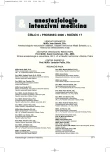Flumazenil – a specific antagonist of the benzodiazepines at the beginning of the 21st century. Is it needed?
Authors:
L. Hess 1; J. Málek 2; J. Schreiberová 3
Authors‘ workplace:
Centrum experimentální medicíny, IKEM Praha
1; Klinika anesteziologie a resuscitace 3. LF UK a FNKV Praha
2; Klinika anesteziologie, resuscitace a intenzivní medicíny, FN Hradec Králové
3
Published in:
Anest. intenziv. Med., 17, 2006, č. 6, s. 295-298
Category:
Anaesthesiology - Comprehensive Report
Overview
Flumazenil was developed in 1979 during a search for new agonists of the benzodiazepine receptor discovered 2 years earlier in 1977. Flumazenil was registered as a benzodiazepine antagonist by Roche (brand name Anexate) in Switzerland in 1987. Similar drugs with longer duration of effect were tested but only Sarmazol is used and that is in veterinary anaesthesia. Other derivates are used in experiments only.The main boom of flumazenil use was in the 80s and early 90s, later on its popularity decreased because of its high cost and short-lasting effect. The main indications for flumazenil are a reversal of the paradoxical reaction to midazolam and antagonism of conscious sedation induced by the benzodiazepines. A common intravenous dose of 0.5 mg of flumazenil accelerates psychomotoric recovery from midazolam for 60 minutes. Intranasal and rectal applications of flumazenil have also been described mainly in children. Interesting effects of flumazenil include the reversal of halothane-induced sedation and the potentiation of the hypnotic effects of propofol and of the antinociceptive effect of morphine.
Key words:
benzodiazepines – flumazenil – history
Labels
Anaesthesiology, Resuscitation and Inten Intensive Care MedicineArticle was published in
Anaesthesiology and Intensive Care Medicine

2006 Issue 6
Most read in this issue
- Physostigmine and its place in modern anaesthesiology and intensive care
- Flumazenil – a specific antagonist of the benzodiazepines at the beginning of the 21st century. Is it needed?
- Measurement of cardiac output by the pulse contour analysis (LiDCOTM plus) and the partial rebreathing of carbon dioxide (NICO) methods – a prospective comparative study
- TOF-Watch® SX vs. Datex-Ohmeda M-NMT: A comparison of the TOF-ratio measured with accelerometry or electromyography. A clinical, prospective, controlled study.
